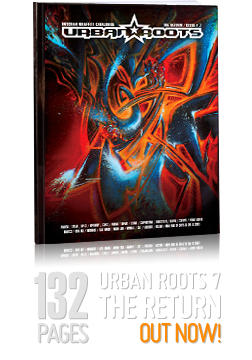Graffiti dictionary
BEEF: Disagreement or conflict.
BENCH: (n) Subway station where writers congregate and watch trains. Benching (v) The act of watching trains.
BITE: Plagiarism
BLOCK BUSTER: Wide lettered piece stretching from end to end done below window level on subway car.
BMT: NYC subway division called Brooklyn Manhattan Transit company. Includes J, L, M, N, Q, R, Z subway lines.
BOMB: Prolific writing
BUFF: Removal of writing/art work
THE BUFF: The MTA’s graffiti removal program
BURN: 1. To out do the competition. 2. To wear out.
CREW: Organized group of writers
CROSSING OUT: To scribble or write on someone else’s name. It is considered highly disrespectful.
DEF: Excellent (derived from definite and death).
DESIGNS: Polka dots, checkers stars swirls are placed over the fill-in to in hence and compliment fill-in . Designs are limited only by an artists imagination and technical ability.
DOPE: Excellent, of the highest order.
DOWN: Part of a group or action
FADE: Graduation of colors.
FAMLIES: Rows of throw-ups of the same name.
FLOATERS: throw-ups done on subway car panels at window level.
FREIGHTS: Railroad freight cars.
GETTING UP: When proliferation of name has led to high visibility.
GETTING OVER: Succeeding
G0ING OVER: Writing over another writers name. It is the ultimate act of disrespect.
FILL-IN: The base colors of a piece, falling within the outline.
HAND STYLE: Handwriting or tagging style.
HIT: (n) A tag, throw-up or piece (v) the act of writing.
INSIDES:Subway car interiors.
KILL: To bomb excessively.
KING: The most accomplished writer in a given category.
LAY-UP: A single or double track where trains are parked during off-peak hours. Both tunnel and elevated lay-ups exist.
MARRIED COUPLE: Two subway cars permanently attached which share a motor. Identified by their consecutive numbers. These cars were desirable when art work on connected car was directly relevant.
NEW SCHOOL: Contemporary writing culture (post 1984).
This date can vary greatly depending upon who you ask.
OLD SCHOOL: The writing culture prior to 1984.
This date can vary greatly depending upon who you ask.
OUTLINE: The skeleton or frame work of a piece
FINAL OUTLINE: After fill-in and designs have been applied the outline is re-executed to define the letters.
PANEL PIECE: A painting below the windows and between the doors of a subway car.
PIECE: A writer’s painting, short for masterpiece.
PIECING: The execution of a piece.
PIECE BOOK OR BLACK BOOK: A writer’s sketch book. Used for personal art development and or the collection of other artists work.
PRODUCTION: Large scale murals with detailed pieces and illustrations. (Contemporary term used mainly for street murals.)
PULL-IN PULL-OUT: This is essentially a five to fifteen minute lay-up. At the end of some subway routes trains park in a tunnel for several minutes before going back into service. During this time the trains are written on. Due to time constraints pull in-pull outs were generally utilized for throw-ups. It was one of the more dangerous approaches to writing.
ROLLER LETTERS: Names rendered with bucket paint and rollers.
SCRATCHITI: A media coined term for the scratchings rendered on to the windows of subway cars.
STEEL: Any type of train. New school term used to distinguish train and wall work.
STYLE WARS: 1. Competition between artists to determine superior creative ability.
2. Documentary film on Hip Hop by Henry Chalfant and Tony Silver (RIP). Proved to be an extremely inspirational element for the New School.
TAG: (n) A writer’s name and signature. (v) The execution of a signature.
TAGGING-UP: The execution of a signature.
THROW-UP: A quickly executed piece consisting of an outline with or without thin layer of spray paint for fill-in.
THROWIE: Contemporary term for throw-up.
TOP-TO-BOTTOM or (T to B): A piece which extends from the top of the subway car to the bottom.
TOY: 1. Inexperienced or incompetent writer.
2. A small felt tip marker.
WALL PAPER: Repetition of a name written making enough coverage so that a pattern develops, much like wall paper.
WILD STYLE: 1. Bronx crew from the 1970s led by Tracy 168.
2. A complicated construction of interlocking letters.
3. Classic film on Hip Hop culture directed by Charlie Ahearn.
WRITER: Practitioner of the art of writing.

